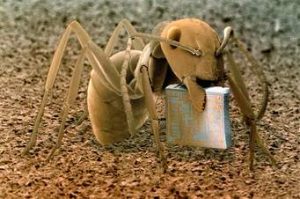
I saw a presentation of the ideas in Staying with the Trouble: Making Kin in the Cthulucene and Anna Tsing’s The Mushroom at the End of the World at the ASLE gathering in Idaho in 2015. This book brings together the ideas that Haraway and Tsing explored there and develops the idea of the Cthulucene–an entangling of all the living things here on earth–as an alternative response to the Anthropocene and the Capitalocene. Her argument is that:
“The task is to make kin in lines of inventive connection as a practice of learning to live and die well with each other in a thick present. Our task is to make trouble, to stir up potent response to devastating event, as well as to settle troubled waters and rebuild quiet places” (2016, location 297).
Haraway asserts that looking to the future–in either utopian or apocalyptic terms–is useless and looking to some mythical past is worst. Current concern and current action, being-together in the present, is more important than any other approach to an always already posthuman world. She uses creative approaches and collectives to find a path to “making kin” among those that populate the world with us.
Haraway, Donna J. Staying with the Trouble: Making Kin in the Cthulucene. Durham: Duke University Press, 2016.
Leave a Reply
5 Comments on "Staying-with the Trouble: Haraway and the Cthulhucene"
Thanks for presenting us for an entirely new book by Haraway, I haven’t read it yet but the sym-poiesis thought (making-with) sounds beautiful. It sounds like a book that could be useful in an analysis of the semi-living art that Pernille talked about in the last lecture, do you think that is the case?
Thanks, Eva. Yes, I do. I think that I will use it for my final essay because it makes visible a path that Latour, with his social assemblages, has noted, as has Barad: We are all always entangled with others, both human and non-human, and the idea of true individuality is a myth. All we have and are depends upon interactions with the world and we cannot exist otherwise. I find the posthuman fascinating, partly because of the fears and hopes that are weighted into a future world, without even noticing that we’re already there, yes?
Thank you for bringing Haraways Cthulucene up and the exciting linking to Anna Tsing. I recommend an article about Haraways conception of the Cthulucene as well. I think it’s a really fascinating and beautiful way of thinking our position and inter/intrarelations in the world.
In the article her mainconcern is the climate changes and with the chulucene she is calling for action. But how is it in the book? And how do you understand her unpleasant with the word posthuman?
Hi Katrine, I saw your post. Thanks for your response. I think that she is uncomfortable with this idea that we’re moving past the human, rather than realizing that the human was not that unique anyhow. I really like her approach to change. She sees climate change as an opportunity to adjust our being-in-the world, I think. She wants us to consider our footprint and our dependence on others for survival, together. What do you think about her take on the posthuman?
I highly agree with your observation! I think like you she reacts on the idea of the posthuman as something which comes after and replaces the human. With the climate changes there is both an opportunity to adjust our being-in-the world but it also shows a urgent need for it. Her democratic way to see us as entangled and interconnected with everything else not as bad thing, but as a way to cooperate in “saving” the planet is in my opinion amazing.